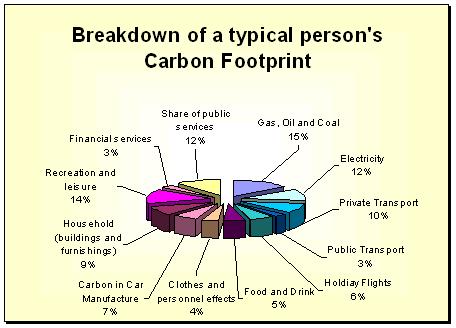 A carbon footprint is defined as:
A carbon footprint is defined as:
The total amount of greenhouse gases produced to directly and indirectly support human activities, usually expressed in equivalent tons of carbon dioxide (CO2).
A measure of the total amount of carbon dioxide (CO2) and methane (CH4) emissions of a defined population, system or activity, considering all relevant sources, sinks and storage within the spatial and temporal boundary of the population, system or activity of interest. Calculated as carbon dioxide equivalent (CO2e) using the relevant 100-year global warming potential.
In other words: When you drive a car, the engine burns fuel which creates a certain amount of CO2, depending on its fuel consumption and the driving distance. (CO2 is the chemical symbol for carbon dioxide). When you heat your house with oil, gas or coal, then you also generate CO2. Even if you heat your house with electricity, the generation of the electrical power may also have emitted a certain amount of CO2. When you buy food and goods, the production of the food and goods also emitted some quantities of CO2.
fuel which creates a certain amount of CO2, depending on its fuel consumption and the driving distance. (CO2 is the chemical symbol for carbon dioxide). When you heat your house with oil, gas or coal, then you also generate CO2. Even if you heat your house with electricity, the generation of the electrical power may also have emitted a certain amount of CO2. When you buy food and goods, the production of the food and goods also emitted some quantities of CO2.
Your carbon footprint is the sum of all emissions of CO2 (carbon dioxide), which were induced by your activities in a given time frame. Usually a carbon footprint is calculated for the time period of a year.
Transportation officials are striving to make their practices and policies greener and more sustainable. So how do you measure the greenness of a pavement? It’s all about the carbon – how, when and whether it is counted.
 This paper examines greenhouse gas production of asphalt and concrete pavements. The analysis shows clearly that asphalt has a much lower carbon footprint than concrete. When it comes to pavement, asphalt is the more sustainble choice.
This paper examines greenhouse gas production of asphalt and concrete pavements. The analysis shows clearly that asphalt has a much lower carbon footprint than concrete. When it comes to pavement, asphalt is the more sustainble choice.
Download the full document here .